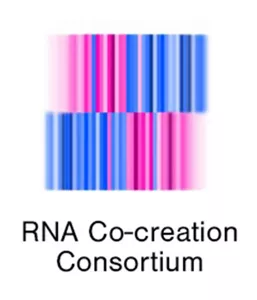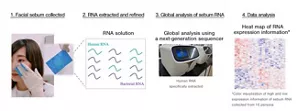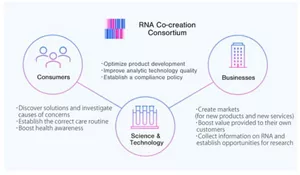Kao and istyle Establish the RNA Co-creation Consortium
Setting New Standards for Making, Selling and Selecting
Beyond Company Boundaries
Working to Create a Sustainable Consumption Cycle
Across the Entire Beauty and Health Industries
On March 11, 2024, Kao Corporation and istyle Inc. jointly established the RNA Co-creation Consortium, centering on Kao’s sebum RNA monitoring*1 technology. Through the Consortium, the companies aim to achieve business co-creation and sustainable growth of the beauty and health industries.
Kao, which will provide sebum RNA monitoring technology, and istyle, Japan’s largest beauty-specialized platform, will serve as directors of the Consortium and have set up a steering committee. Co-creation partners KOSÉ Corporation, MatsukiyoCocokara & Co., Kirin Holdings Company, Limited, Perfect Corp. and Healthcare Systems Co., Ltd., all leading companies in their respective fields, will act as coordinator companies.
The future aim of the Consortium is to create a framework, based on RNA information, that offers consumers a more satisfying selection of personalized products and services. At the same time, by fine-tuning supply and demand, the Consortium hopes to establish a sustainable consumption cycle that does not burden people or the environment.

-
* 1 Kao News Release dated June 10, 2019
Kao’s original non-invasive analytical method for monitoring RNA - Discovery of the presence of human RNA in sebum
Background
With the 100-year lifespan fast becoming reality, there is an increased focus on living life healthily and comfortably. A wealth of information and beauty and health services is available, but many consumers are bewildered by the profusion of alternatives available and wonder what products and services suit them best. This has made the beauty and health industries increasingly aware of the need for creating standards according to which consumers can obtain correct knowledge about their current condition and judge what they need most to accomplish their goals out of the numerous alternatives available.
Meanwhile, businesses are expected to provide diverse products and services and conduct their activities in line with ESG (Environment, Social, Governance) principles. By suggesting the quickest and most appropriate choices from among numerous alternatives, individual businesses providing services can create new markets that are less burdensome to people and the environment.
Sebum RNA monitoring technology
Kao developed sebum RNA monitoring technology, a method for global analysis of RNA extracted from facial sebum collected with oil blotting film. (Figure 1) Whereas DNA is information particular to an individual that remains the same throughout the person’s lifetime, RNA varies from day to day depending on environmental factors like physical condition, diet, exercise, stress or UV rays, which makes it useful for learning about the skin’s condition at a particular time. Kao has so far announced research results indicating that sebum RNA can help hint at various skin and other physical conditions and has the potential to enable early detection of pediatric atopic dermatitis or Parkinson’s disease.

Figure 1. RNA monitoring process: Collection of facial sebum, extraction and refinement of RNA, analysis of data
Consortium starting point initiative by Kao and istyle
In 2022, Kao and istyle began working on a study grouping individuals with similar sebum RNA expression information to explore their tendencies in preferences for cosmetics*2 , using facial sebum collected from consenting members of the @cosme website operated by istyle.
Following analysis of clustering based on similarity of sebum RNA expression information, Kao announced that the study had discovered that there are at least two distinct skin types*3 . Based on the sebum RNA and image information obtained through the two companies’ collaboration, technology was also developed using photos of faces to classify the skin types (skin gene mode), something which had previously only been possible by collecting sebum directly from the skin.
-
* 3 Kao News Release dated March 6, 2024
Skin Type Classification Using Sebum RNA Developed Two Skin Types with Different Gene Expression (RNA) Characteristics Discovered
Aims and activities of the RNA Co-creation Consortium
The work done by Kao and istyle so far has highlighted that using RNA information can potentially be useful as a criterion for selecting cosmetics. The two companies’ joint project sparked the creation of the RNA Co-creation Consortium, with the aim of working with different enterprises to create businesses centered on sebum RNA monitoring technology.
The Consortium’s work will include setting and standardizing parameters for making, selling and selecting beauty and health care services, testing business use cases, supporting business tie-ups and other activities. Wide provision of health and beauty care and related services based on RNA information will enable consumers to choose more satisfying alternatives. The Consortium initiative can also motivate companies in various spheres of business, including beauty and health care, to propose solutions addressing consumers’ concerns and promote innovation in developing new products and services.
The Consortium will invite a broad range of companies in the beauty, health and food industries to join, to involve the whole of the beauty and health industries, working toward the sustainable growth of the industry by combining the data and expertise of member companies to promote solutions for consumer and industry issues and create new value.

Figure 2. Conceptual image of activities at touch points linked with the RNA Co-creation Consortium
About the RNA Co-creation Consortium
Formal name: RNA Co-creation Consortium
Director Companies (Steering Committee)

Participating Companies (Coordinator Companies)

Consortium activities
-
Supporting and promoting verification tests of projects using sebum RNA monitoring technology (verification activities)
- Design and test new solutions addressing consumers’ concerns
- Promote innovation in developing new products and services in the areas of beauty and health care
- Use consumer data in accordance with strict data protection measures and policies
-
Supporting business matching and tie-ups inside and outside the RNA Co-creation Consortium
- Communicate verification test results obtained by the Consortium to the public
- Support social implementation of results obtained through verification tests
- Establishing strict policies concerning RNA data protection and privacy
About Kao
Kao creates high-value-added products and services that provide care and enrichment for the life of all people and the planet. Through its portfolio of over 20 leading brands such as Attack, Bioré, Goldwell, Jergens, John Frieda, Kanebo, Laurier, Merries, and Molton Brown, Kao is part of the everyday lives of people in Asia, Oceania, North America, and Europe. Combined with its chemical business, which contributes to a wide range of industries, Kao generates about 1,530 billion yen in annual sales. Kao employs about 34,300 people worldwide and has 137 years of history in innovation. Please visit the Kao Group website for updated information.
Media inquiries should be directed to:
Public Relations
Kao Corporation
